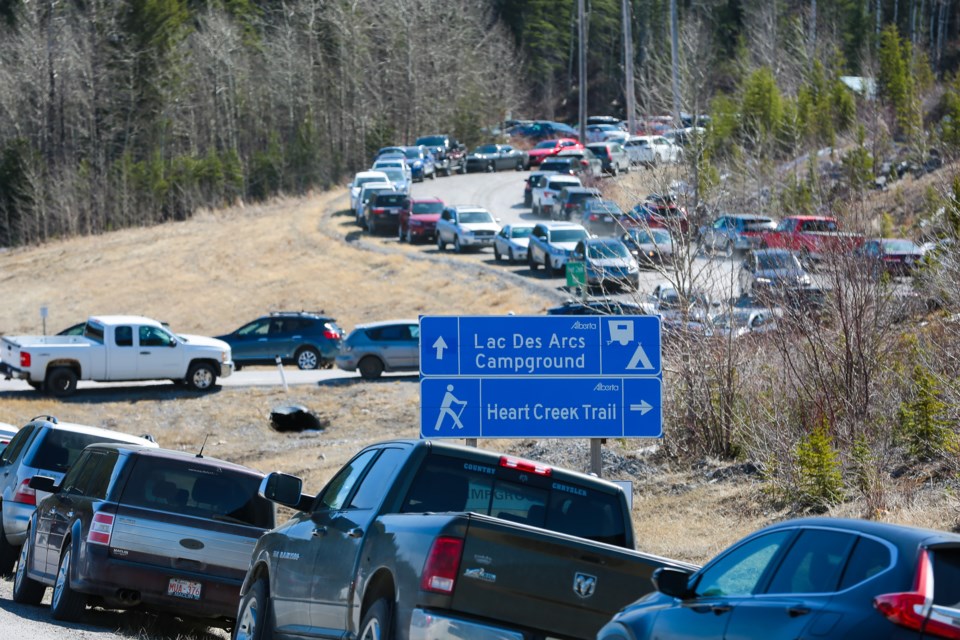KANANASKIS – The provincial government appears to have gone back on a commitment that 100 per cent of the Kananaskis Conservation Pass would be reinvested into the treasured area.
The province is deploying 19 new conservation officers across the province under a $1.5 million initiative generated from revenue from the Kananaskis Conservation Pass, but only six of those 19 positions are dedicated to K-Country.
Conservationists say the hiring of six new officers for K-Country is great news for the area as it faces increasing pressure from exploding visitation, but question why revenue generated from the mandatory pass is being spent on officers to be deployed elsewhere as well.
“Most of the $1.5 million is not going into Kananaskis so obviously the Kananaskis Conservation Pass is not just for Kananaskis,” said Sarah Elmeligi, a Canmore-based conservationist and former provincial park planner.
“People are paying to go into a park on the assumption that money is going to go back into the park, but the numbers don’t add up … if it’s not going back into the park or even into provincial parks, then people are being charged this fee on a false pretense.”
Vehicles parked at provincial park and public land sites in Kananaskis Country and the Bow Valley need a Conservation pass; a day pass costs $15 per vehicle per day while an annual pass allows for two vehicles to be registered under the same pass rings in at $90.
The pass, which came into effect in June 2021 after record visitation in 2020 strained the protected area’s resources and wildlife, aims to offset costs of conservation efforts, search and rescues, services and infrastructure.
When the pass was announced in April 2020, Alberta Environment and Parks Minister Jason Nixon said the revenue from each pass will go directly back towards enhancing conservation activities, services and facilities in Kananaskis.
“We are investing 100 per cent of the revenue from the pass back into Kananaskis,” said Nixon during his announcement. “This conservation pass is about managing demand and environmental sustainability.”
A total of 19 new conservation officers will be deployed across the province to work on education, prevention and enforcement, by responding to incidents, conducting patrols, delivering educational programs and serving as champions for the great outdoors. Six of the 19 will be stationed in K-Country.
According to the government press release, $1.5 million in revenues from the pass were directed to support the hiring and training of these new officers.
Between October 2021 and January 2022, the new conservation officers completed induction training at the Hinton Training Centre.
With the addition of these new officers, there are now 82 conservation officers across the province.
The addition represents an increase of approximately one-third of the existing force.
Jason Nixon, Alberta Minister of Environment and Parks, said the province has delivered on a commitment to put “more boots on the ground.”
“With more Albertans than ever before exploring Alberta’s provincial parks and public lands, conservation officers have never been more important,” he said in a March 18 news release.
“I am looking forward to seeing Alberta’s new class of officers in the field as we head into what is sure to be another busy season.”
Elmeligi said the boost in six frontline conservation officers to K-Country is a “step in the right direction.”
“It is hugely beneficial because that capacity is sorely needed,” she said. “Will it be enough? I guess that remains to be seen.”
Elmeligi said conservation officers play important roles on the landscape through both education and enforcement.
“With more than five million visitors a year, more conservation officers on the ground to talk to more people and to inform them of regulations and legislation and expected behaviours is great,” she said.
The Kananaskis Conservation Pass raised $11 million in revenue last year.
Under the 2022 provincial budget, Alberta Environment and Parks gets $604 million – an increase of $105 million from the previous budget – but Parks were allocated $75 million. The 2020-21 budget for Parks was $76 million and rose to $81 million last year.
Conservationists say more transparency is needed around how the money from the Kananaskis Conservation Pass is spent, noting the 2022 provincial budget provides no clarity on where the money is going.
“One of the things I’m still struggling a little bit with is the Kananaskis Conservation Pass raised $11 million last year, but Alberta Parks’ budget has not increased by $11 million,” said Elmeligi.
To enforce the Kananaskis Conservation Pass, licence plates of vehicles parked in the area will be scanned. Owners of non-compliant vehicles may receive a warning or be sent a fine in the mail.
Unless exempt, a fine for not purchasing a pass for personal vehicles is $150.
A spokesperson for Alberta Environment and Parks did not immediately get back to the Outlook on questions about the pass. The story will be updated if we hear from them.




